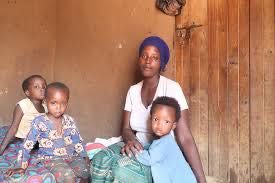
By Eric Didier Karinganire
In a tiny living room, Lydia Nishimwe, a Burundian refugee in Mahama camp, laughs while playing with her children. Her youngest child, 11-month-old Clarisse Izodukiza, clings to her mother, eager to join her older siblings in play. Lydia feels happy because her daughter is getting better after many hard days.
Clarisse, her mother explains, has started regaining strength over the last few months thanks to supplementary foods, as she was diagnosed as underweight at the health center in Mahama refugee camp five months ago.
“When we first arrived at the health centre, my daughter weighed 5 kg at six months and was suffering from diarrhea. Health practitioners told me that this could indicate malnutrition,” Lydia recounts. “But with the regular check-ups, nutritional supplements, and health education sessions provided by Save the Children, she’s now healthier and more active; she weighs 7 kg at 11 months.”
Refugee parents like Lydia, who have children facing malnutrition across all camps in Rwanda, receive nutrition education and supplementary foods through a joint initiative spearheaded by UNHCR, the UN Agency for Refugees, and the World Food Programme (WFP), working alongside the Government of Rwanda through the Ministry in charge of Emergency Management (MINEMA).
This nutrition programme helps restore lost nutrients, ensure weight gain, and support the overall recovery and rehabilitation of refugee children experiencing Moderate Acute Malnutrition (MAM). For families like Lydia’s, the joint initiative has been a lifeline, offering hope in an otherwise precarious situation.
Despite the positive changes, some challenges remain. Figures from the 2023 Standardised Expanded Nutrition Survey (SENS) reveal that acute malnutrition has increased since 2021 for the first time in seven years in most of the refugee camps.
For instance, acute malnutrition has increased from 3.8% to 5.9% in Kiziba refugee camp and from 2.8% to 6.1% in Mahama refugee camp. The only improvement was recorded in Nyabiheke with a noteworthy decline from 2.8% to 0.4%.
Lydia points to diminishing humanitarian aid and escalating food price inflation as the primary factors that prevented her from meeting the nutritional requirements her daughter needed for healthier growth.
“Before, I could buy fruits or milk for my younger children once a week. But now, with reduced cash transfers and lack of other assistance, we struggle to make it last even a week and a half,” Lydia explains. “And the rising prices for food in the market make things even harder for us.”
The mother of five says her husband tries to work as a laborer in the host community, but the informal work and lack of consistent income mean his earnings can’t cover all the family’s basic needs including food.
Despite persisting challenges, UN agencies in Rwanda continue to collaborate closely with the Rwandan Government and other partners to enhance the nutritional standards of refugees and their Rwandan hosts. Through various initiatives and programmes, such as distributing fortified foods, providing nutritional education, and supporting agricultural projects, tackling malnutrition remains high on the agenda for all. [Source : UNHCR]. (End)
